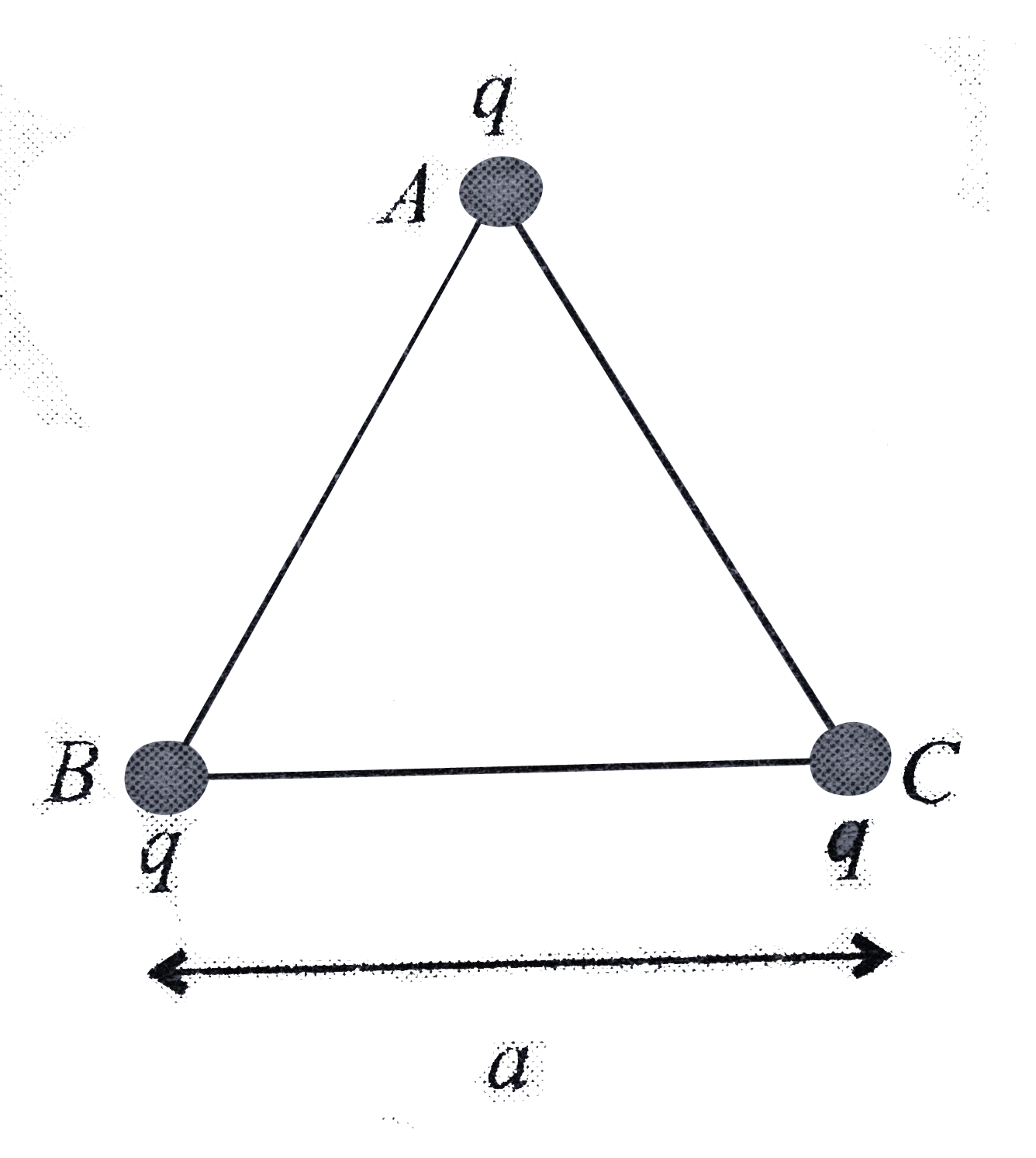Three equal charge each are placed at three corners of an equilateral triangle of side 'a'. Find out force acting on one of the charge due to other two charges ?
The correct Answer is:(i) , away from the charges along perpendicular bisector of line joining remaining two charges.
(ii) ; towards the charges along perpendicular bisector of line joining remaining two charges.
(iii) ; away from the charges along angle bisector.
To find the force acting on one of the charges due to the other two charges placed at the corners of an equilateral triangle, we can follow these steps:
Step 1: Identify the Charges and Their Positions
Let the three equal charges be q0 placed at the corners of an equilateral triangle with side length a. Denote the charges as Q1,Q2, and Q3.
Step 2: Determine the Forces Acting on One Charge
We will calculate the force acting on charge Q1 due to charges Q2 and Q3. The forces acting on Q1 are:
- The force F12 due to charge Q2
- The force F13 due to charge Q3
Step 3: Calculate the Magnitude of Each Force
Using Coulomb's Law, the magnitude of the force between two point charges is given by:
F=k|q1q2|r2
For our charges, the distance r between any two charges is a:
F12=F13=kq20a2
Step 4: Determine the Angle Between the Forces
Since the charges are at the corners of an equilateral triangle, the angle θ between the forces F12 and F13 is 60∘.
Step 5: Use the Law of Cosines to Find the Resultant Force
The resultant force F1 acting on charge Q1 can be found using the formula for the resultant of two vectors:
F1=√F212+F213+2F12F13cosθ
Substituting F12=F13=F and θ=60∘:
F1=√F2+F2+2F2⋅12=√2F2+F2=√3F2=√3F
Step 6: Substitute the Value of F
Now substituting F=kq20a2:
F1=√3(kq20a2)
Final Result
Thus, the force acting on charge Q1 due to the other two charges is:
F1=√3kq20a2
Let the three equal charges be q0 placed at the corners of an equilateral triangle with side length a. Denote the charges as Q1,Q2, and Q3.
We will calculate the force acting on charge Q1 due to charges Q2 and Q3. The forces acting on Q1 are:
- The force F12 due to charge Q2
- The force F13 due to charge Q3
Using Coulomb's Law, the magnitude of the force between two point charges is given by:
F=k|q1q2|r2
For our charges, the distance r between any two charges is a:
F12=F13=kq20a2
Since the charges are at the corners of an equilateral triangle, the angle θ between the forces F12 and F13 is 60∘.
The resultant force F1 acting on charge Q1 can be found using the formula for the resultant of two vectors:
F1=√F212+F213+2F12F13cosθ
Substituting F12=F13=F and θ=60∘:
F1=√F2+F2+2F2⋅12=√2F2+F2=√3F2=√3F
Now substituting F=kq20a2:
F1=√3(kq20a2)
Thus, the force acting on charge Q1 due to the other two charges is:
F1=√3kq20a2
Topper's Solved these Questions
- ELECTROSTATICSBOOK - RESONANCE ENGLISHCHAPTER - ELECTROSTATICSEXERCISE - Part - II
23 Videos
- ELECTROMAGNETIC INDUCTIONBOOK - RESONANCE ENGLISHCHAPTER - ELECTROMAGNETIC INDUCTIONEXERCISE - A.l.P
19 Videos
- EXPERIMENTAL PHYSICSBOOK - RESONANCE ENGLISHCHAPTER - EXPERIMENTAL PHYSICSEXERCISE - PART -II
10 Videos
Similar Questions
Three point charges q are placed at three vertices of an equilateral triangle of side a. Find magnitude of electric force on any charge due to the other two.
View SolutionFour identical charges q are placed at the corners of a square of side a. Find the potential energy of one of the charges due to the remaining charges.
 .
.
View Solution
Knowledge Check
Consider the charges q,q and -q placed at the vertices of an equilateral triangle of each side l. What is the force on each charge ?
Aq24√2πε0l2B−q24πε0l2Cq24πε0l2Dzero
Three equal charges q are placed at the corners of an equilateral triangle of side A.
(i) Find out potential energy of charge system.
(ii) Calculate work required to decrease the side of triangle to a/2.
(iii) If the charges are released from the shown position and each of them has same mass m, then find the speed of each particle when they lie on triangle of side 2a.
 .
.
View SolutionThree equal charges q are placed at the corners of an equilateral triangle of side A.
(i) Find out potential energy of charge system.
(ii) Calculate work required to decrease the side of triangle to a/2.
(iii) If the charges are released from the shown position and each of them has same mass m, then find the speed of each particle when they lie on triangle of side 2a.
 .
.
View SolutionThree equal masses of 1 kg each are placed at the vertices of an equilateral triangle of side 1 m, then the gravitational force on one of the masses due to other masses is (approx.)
View SolutionThree points charges of 1C,2Cand3C are placed at the corners of an equilateral triangle of side 100 cm. Find the work done to move these charges to the corners of a similar equilateral triangle of side 50 cm.
View SolutionThree points charges of 1C,2Cand3C are placed at the corners of an equilateral triangle of side 100 cm. Find the work done to move these charges to the corners of a similar equilateral triangle of side 50 cm.
View SolutionFour equal charges 2.0×10−6C each are fixed at the four corners of a squae of side 5 cm. Find the coulomba force eperienced by one of the charges due to the rest three.
View SolutionThree equal masses m are placed at the three corners of an equilateral triangle of side a. find the force exerted by this system on another particle of mass m placed at (a) the mid point of a side (b) at the center of the triangle.
View Solution
